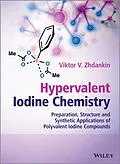Hypervalent Iodine Chemistry is the first comprehensive
text covering all of the main aspects of the chemistry of organic
and inorganic polyvalent iodine compounds, including applications
in chemical research, medicine, and industry.
Providing a comprehensive overview of the preparation,
properties, and synthetic applications of this important class of
reagents, the text is presented in the following way:
* The introductory chapter provides a historical
background and describes the general classification of
iodine compounds, nomenclature, hypervalent bonding, structural
features, and the principles of reactivity of polyvalent iodine
compounds.
* Chapter 2 gives a detailed description of the
preparative methods and structural features of all known
classes of organic and inorganic derivatives of polyvalent
iodine.
* Chapter 3, the key chapter of the book, deals with the
many applications of hypervalent iodine reagents in organic
synthesis.
* Chapter 4 describes the most recent achievements
in hypervalent iodine catalysis.
* Chapter 5 deals with recyclable polymer-supported
and nonpolymeric hypervalent iodine reagents.
* Chapter 6 covers the "green" reactions of
hypervalent iodine reagents under solvent-free conditions or in
aqueous solutions.
* The final chapter provides an overview of the important
practical applications of polyvalent iodine compounds in
medicine and industry.
This book is aimed at all chemists interested in iodine
compounds, including academic and industrial researchers in
inorganic, organic, physical, medicinal, and biological chemistry.
It will be particularly useful to synthetic organic and inorganic
chemists, including graduate and advanced undergraduate students.
It comprehensively covers the green chemistry aspects of
hypervalent iodine chemistry, making it especially useful for
industrial chemists.
Autorentext
Viktor V. Zhdankin was born in Ekaterinburg, Russian Federation. He obtained his BS/MS, 1978 Moscow State University, Ph.D., 1981, Moscow State University, Dr.Chem.Sci., 1987, Moscow State University and Senior Research Associate, 1990-1993, University of Utah.
Klappentext
Hypervalent Iodine Chemistry is the first comprehensive text covering all of the main aspects of the chemistry of organic and inorganic polyvalent iodine compounds, including applications in chemical research, medicine, and industry.
Providing a comprehensive overview of the preparation, properties, and synthetic applications of this important class of reagents, the text is presented in the following way:
- The introductory chapter provides a historical background and describes the general classification of iodine compounds, nomenclature, hypervalent bonding, structural features, and the principles of reactivity of polyvalent iodine compounds.
- Chapter 2 gives a detailed description of the preparative methods and structural features of all known classes of organic and inorganic derivatives of polyvalent iodine.
- Chapter 3, the key chapter of the book, deals with the many applications of hypervalent iodine reagents in organic synthesis.
- Chapter 4 describes the most recent achievements in hypervalent iodine catalysis.
- Chapter 5 deals with recyclable polymer-supported and nonpolymeric hypervalent iodine reagents.
- Chapter 6 covers the green reactions of hypervalent iodine reagents under solvent-free conditions or in aqueous solutions.
- The final chapter provides an overview of the important practical applications of polyvalent iodine compounds in medicine and industry.
This book is aimed at all chemists interested in iodine compounds, including academic and industrial researchers in inorganic, organic, physical, medicinal, and biological chemistry. It will be particularly useful to synthetic organic and inorganic chemists, including graduate and advanced undergraduate students. It comprehensively covers the green chemistry aspects of hypervalent iodine chemistry, making it especially useful for industrial chemists.
Inhalt
Preface ix
1 Introduction and General Overview of Polyvalent Iodine Compounds 1
1.1 Introduction 1
1.2 Classification and Nomenclature of Polyvalent Iodine Compounds 3
1.3 Hypervalent Bonding 4
1.4 General Structural Features 8
1.4.1 Experimental Structural Studies 9
1.4.2 Computational Studies 11
1.5 General Principles of Reactivity 12
1.5.1 Ligand Exchange and Reductive Elimination 13
1.5.2 Radical Reactions 14
1.5.3 Single-Electron Transfer (SET) Reactions 15
References 15
2 Preparation, Structure, and Properties of Polyvalent Iodine Compounds 21
2.1 Iodine(III) Compounds 21
2.1.1 Inorganic Iodine(III) Derivatives 21
2.1.2 Organoiodine(III) Fluorides 23
2.1.3 Organoiodine(III) Chlorides 27
2.1.4 Organo-Iodosyl Compounds 31
2.1.5 Organoiodine(III) Carboxylates 35
2.1.6 [Hydroxy(Organosulfonyloxy)Iodo]Arenes 43
2.1.7 Organoiodine(III) Derivatives of Strong Acids 48
2.1.8 Iodine(III) Heterocycles 50
2.1.9 Iodonium Salts 76
2.1.10 Iodonium Ylides 99
2.1.11 Iodine(III) Species with Three Carbon Ligands 107
2.1.12 Iodine(III) Species with IN Bonds 107
2.2 Iodine(V) Compounds 114
2.2.1 Inorganic Iodine(V) Derivatives 114
2.2.2 Noncyclic and Pseudocyclic Iodylarenes 115
2.2.3 Iodine(V) Heterocycles 120
2.2.4 Organoiodine(V) Fluorides 126
2.3 Iodine(VII) Compounds 127
References 128
3 Hypervalent Iodine Reagents in Organic Synthesis 145
3.1 Reactions of Iodine(III) Compounds 145
3.1.1 Fluorinations 146
3.1.2 Chlorinations 152
3.1.3 Brominations 158
3.1.4 Iodinations 160
3.1.5 Oxidation of Alcohols 164
3.1.6 Oxidative Functionalization of Carbonyl Compounds 168
3.1.7 Oxidative Functionalization of Silyl Enol Ethers 171
3.1.8 Oxidation of Alkenes and Alkynes 173
3.1.9 Oxidations at the Benzylic or Allylic Position 181
3.1.10 Oxidative Functionalization of Aromatic Compounds 182
3.1.11 Oxidative Dearomatization of Phenols and Related Substrates 183
3.1.12 Oxidative Coupling of Aromatic Substrates 196
3.1.13 Oxidative Cationic Cyclizations, Rearrangements, and Fragmentations 201
3.1.14 Oxidations at Nitrogen, Sulfur, and other Heteroatoms 216
3.1.15 Azidations 222
3.1.16 Aminations 230
3.1.17 Thiocyanations and Arylselenations 232
3.1.18 Radical Fragmentations, Rearrangements, and Cyclizations 236
3.1.19 Reactions via Alkyliodine(III) Intermediates 248
3.1.20 Transition Metal Catalyzed Oxidations 250
3.1.21 Transition Metal Catalyzed Aziridinations and Amidations 253
3.1.22 Reactions of Iodonium Salts and C-Substituted Benziodoxoles 260
3.1.23 Reactions of Iodonium Ylides 278
3.2 Synthetic Applications of Iodine(V) Compounds 282
3.2.1 Noncyclic and Pseudocyclic Iodylarenes 283
3.2.2 2-Iodoxybenzoic Acid (IBX) 288
3.2.3 DessMartin Periodinane (DMP) 296
3.2.4 Inorganic Iodine(V) Reagents 302
3.3 Synthetic Applications of Iodine(VII) Compounds 303
References 307
4 Hypervalent Iodine Catalysis 337
4.1 Catalytic Cycles Based on Iodine(III) Species 337
4.1.1 Oxidative Functionalization of Carbonyl Compounds 338
4.1.2 Oxidative Functionalization of Alkenes and Alkynes 342
4.1.3 Oxidative Bromination of Aromatic Compounds 346
…